Moto X Review
by Brian Klug on August 26, 2013 1:30 PM EST- Posted in
- Smartphones
- Qualcomm
- MSM8960
- Motorola
- Android
- Mobile
- Android 4.2
- Moto X
GPU Performance
By Anand Shimpi
Although there’s a CPU core count difference between the MSM8960Pro and the APQ8064 Snapdragon 600 platforms we’ve tested, on the GPU front both use the same IP block: Adreno 320.
The max GPU frequency on the Moto X is 400MHz, compared to 450MHz for the APQ8064 Snapdragon 600 based Galaxy S 4. The difference in GPU frequency is small, and Android games typically have a large CPU bound component so it isn’t totally unfeasible for the Moto X to be among the fastest Adreno 320 phones on the market.
Looking at 3DMark we see just that. The Moto X is the fastest Android phone we’ve tested here. The advantage has nothing to do with GPU frequency however, if we look at CPU frequency over time it’s clear what’s going on.
3DMark
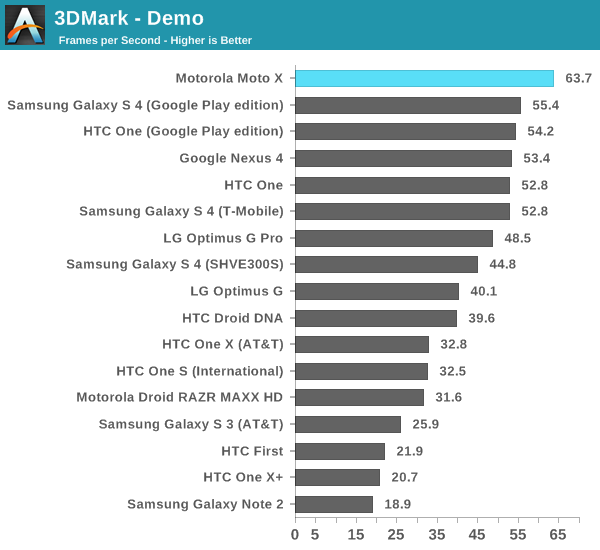
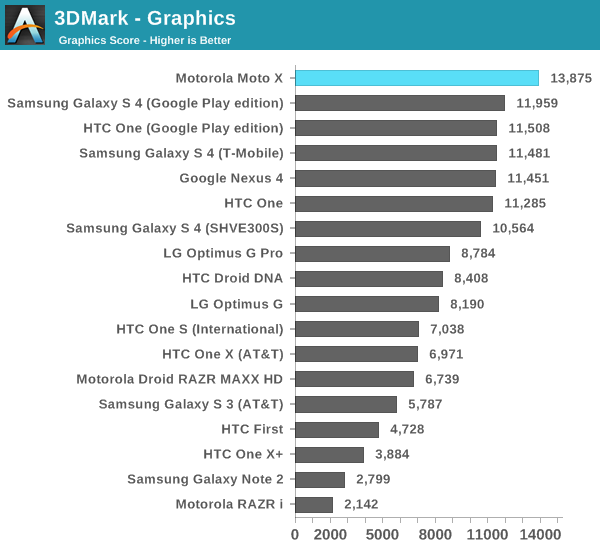
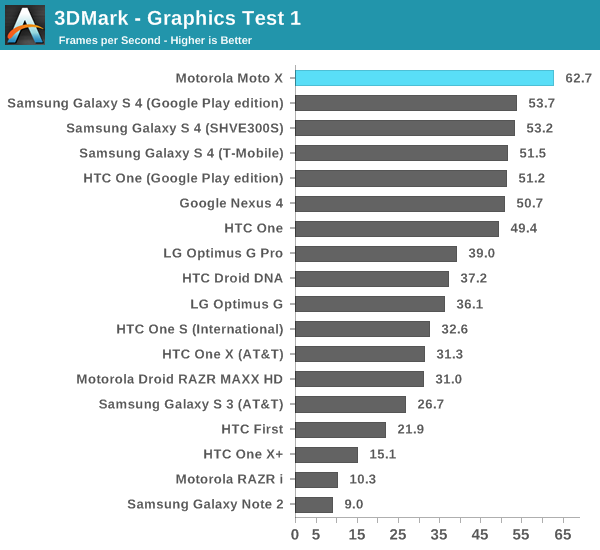
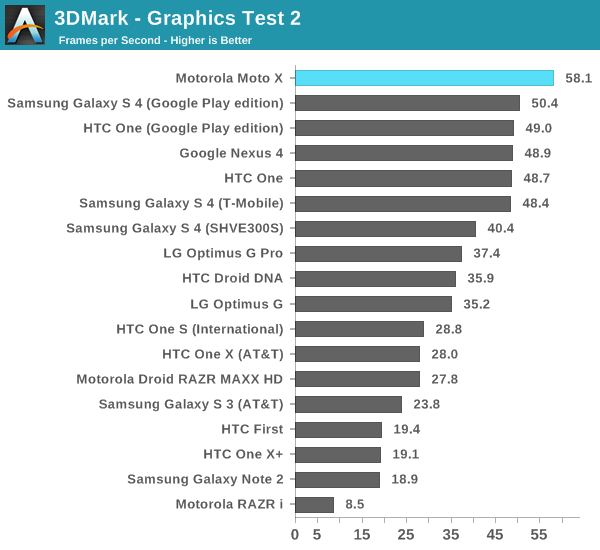
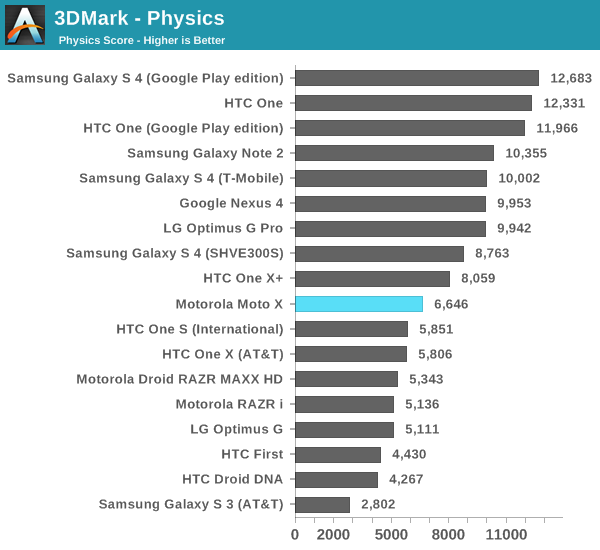
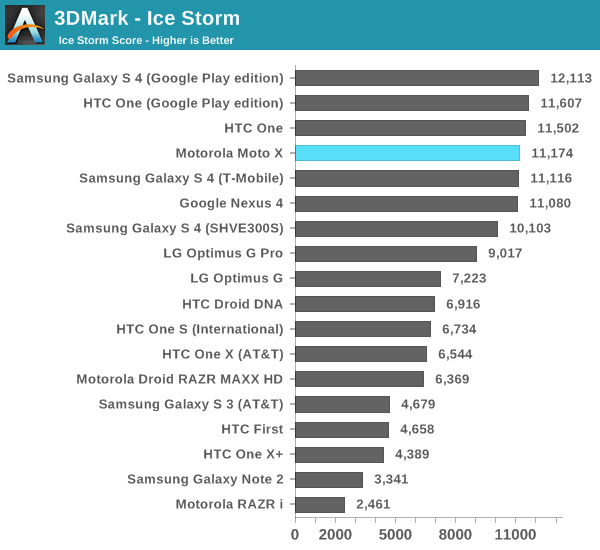
The graphs below show a full 3DMark Ice Storm run, including demo, graphics and physics tests (in that order):
The Moto X’s CPU cores are running at 1.7GHz for all of the 3D tests, and only drop down to lower frequencies during the physics test. The SGS4 by comparison has more cores, running at ~1GHz for most of the benchmark. Given the more CPU bound nature of 3DMark, the Moto X manages to pull ahead.
GFXBench 2.7
BaseMark X and GFXBench 2.7 on the other hand shift the workload to a more GPU bound workload, and we see the Moto X take a couple of steps back.

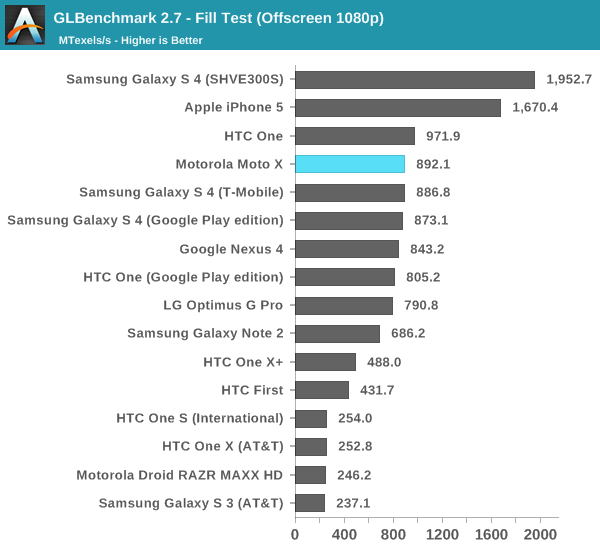
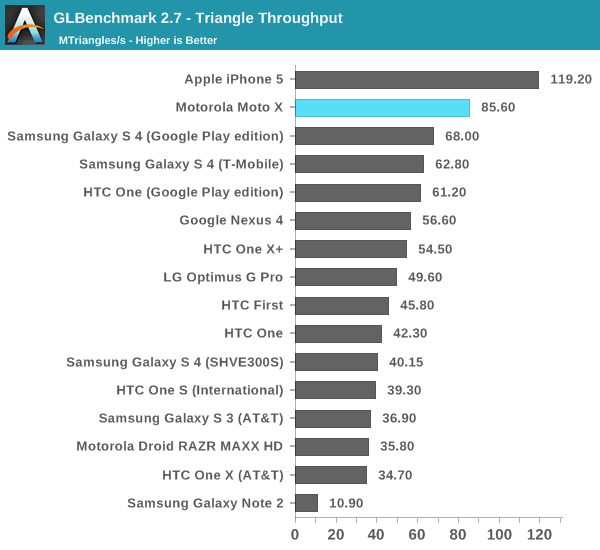
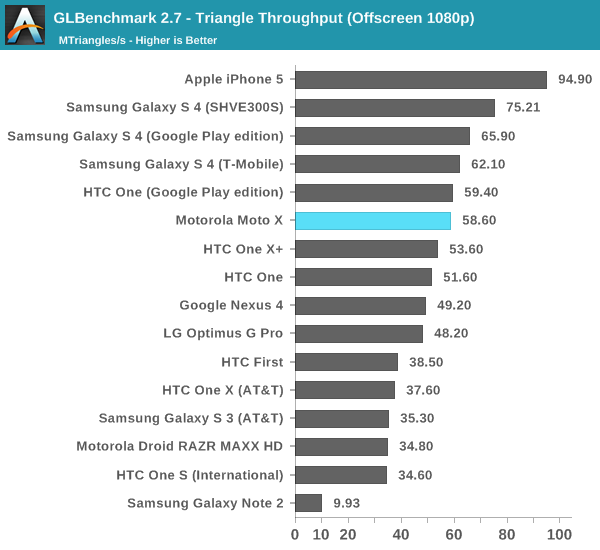
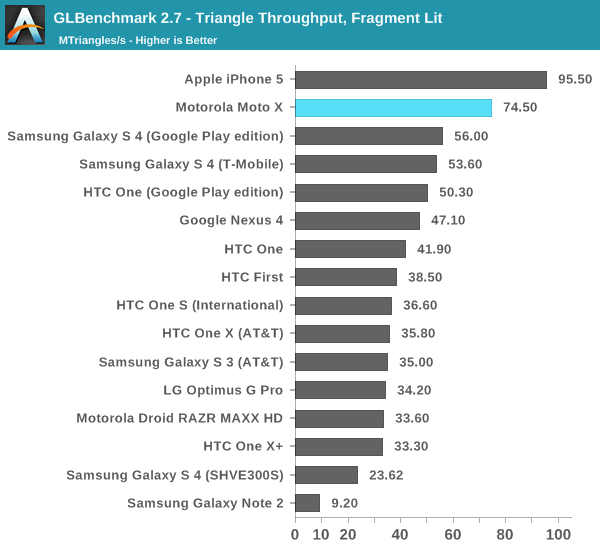
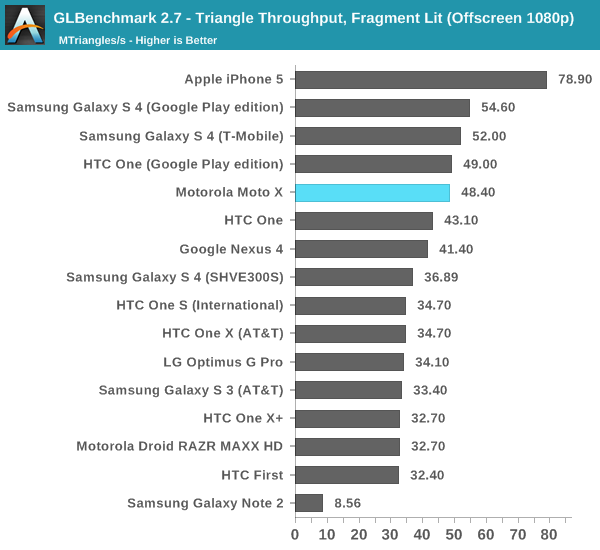


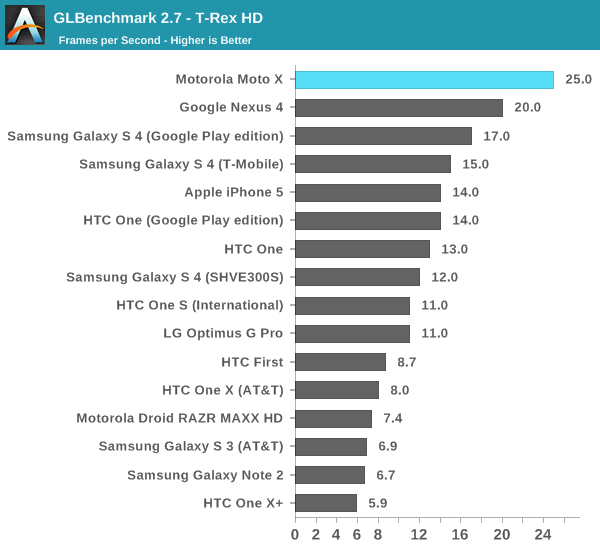
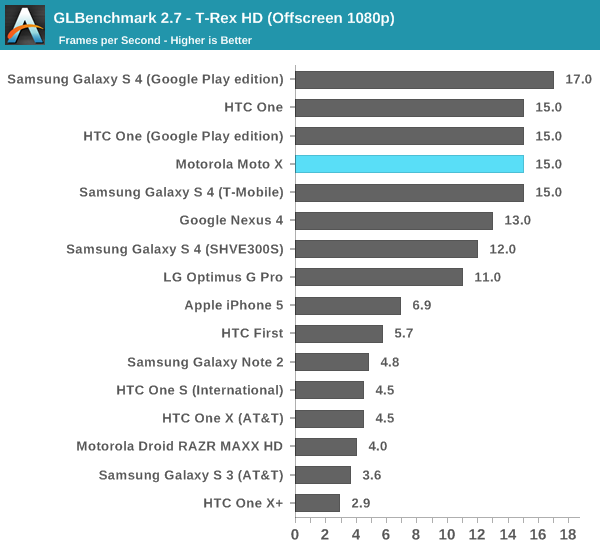
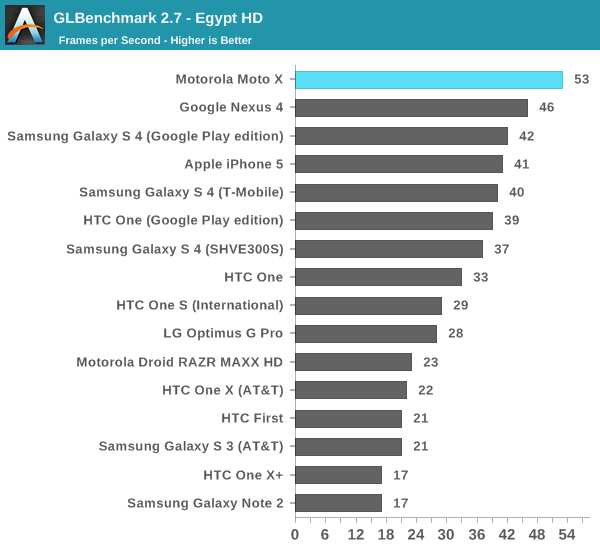
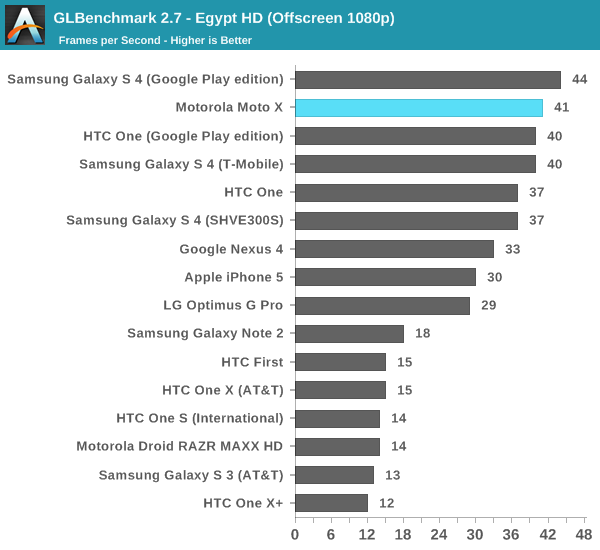
Basemark X
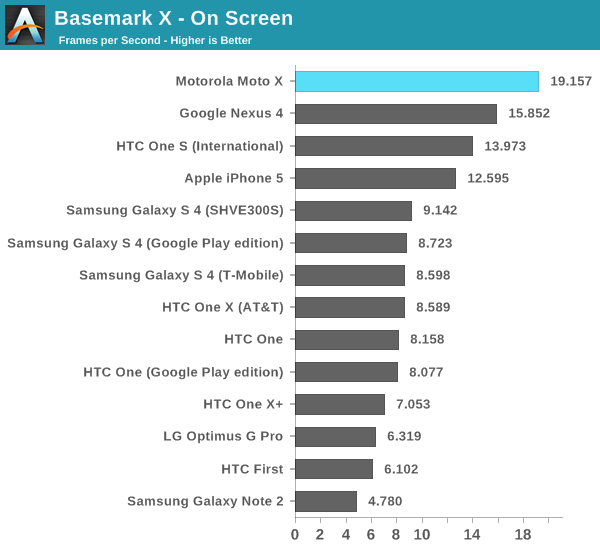

Epic Citadel
Epic Citadel and other native resolution benchmarks benefit from the 720p panel, in addition to the CPU frequency advantages.
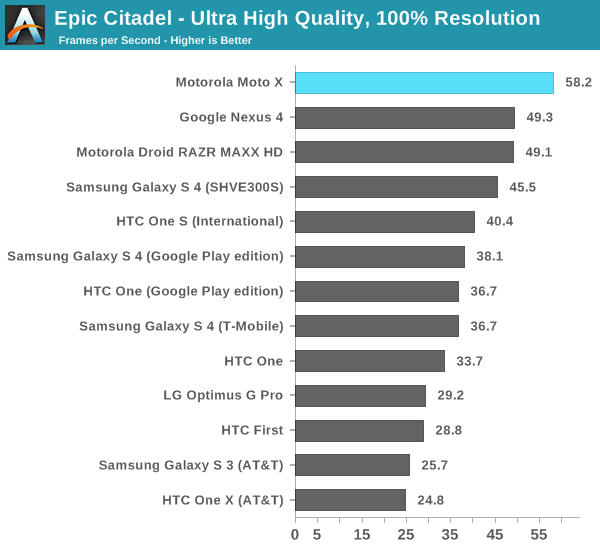


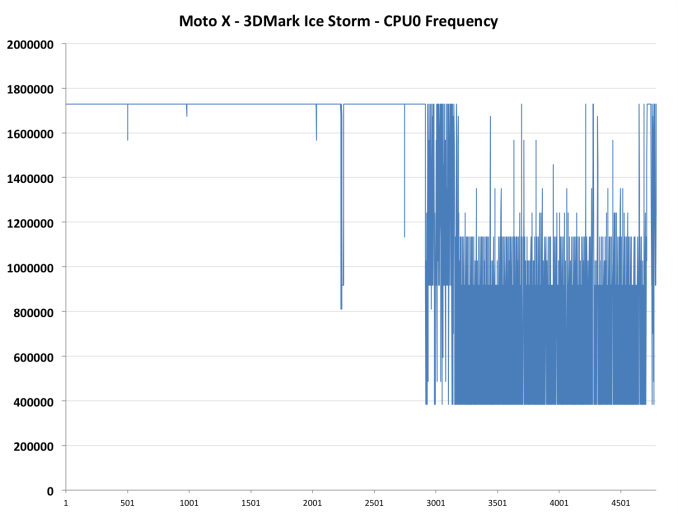
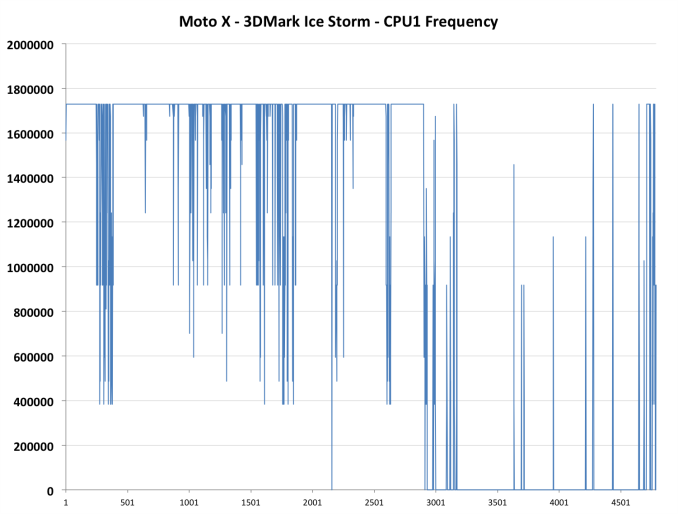
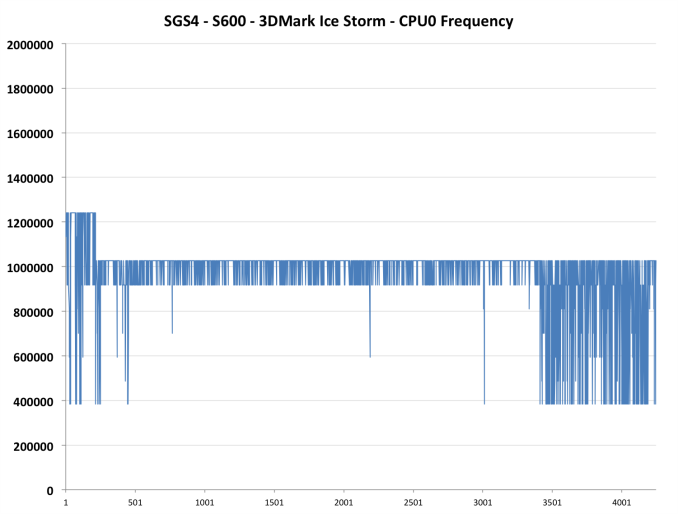
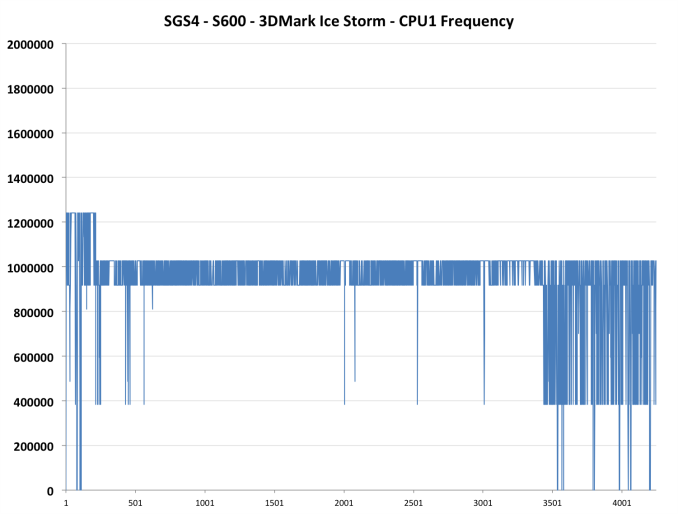

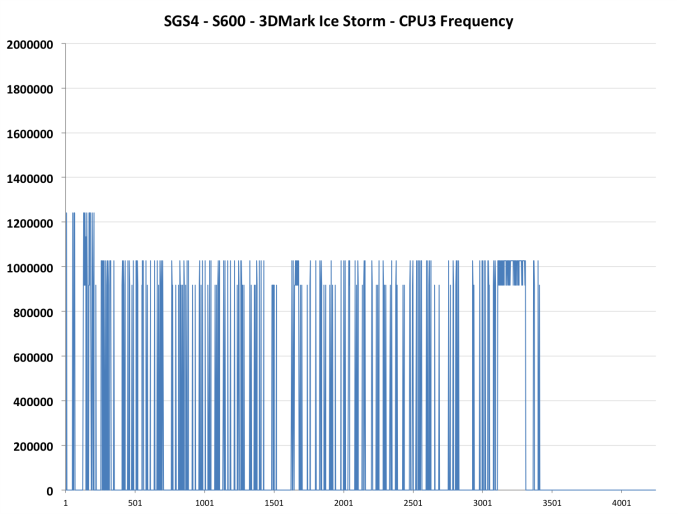








105 Comments
View All Comments
smitty123 - Monday, August 26, 2013 - link
" You have to also be close by, Moto X isn’t going to turn on when you’re across a big room, for example. In addition I’ve noticed that for some reason there are some odd false positives."i don't like to feel like my spied on.
So to me it just sounds like we have a new thing to test: the distance at which the phone can hear us.
Not hear the magic phrase, just how far from us it can still hear us with its 3 mics. forget the "it can't understand us" i'm not testing if it can recognize words, i'm just not comfortable knowing if it can record conversations that a human, nsa for example, can understand. with obama going for the warantless conversation recording, let's just say, this isn't a phone i'd want near me.
That old big brother spying thing is here, i think in the interest of privacy, we need to know these things before buying the phone.
i for one will never get an xbox one just for that reason.
good luck but i'm going back to good old rotary phones lol
flyingpants1 - Wednesday, September 18, 2013 - link
All phones can do that, genius.AnnonymousCoward - Tuesday, August 27, 2013 - link
Does the UI have lag between Android menu screens? Is the touch-screen at least as responsive as every Iphone to come out?I'm guessing there's still plenty of UI lag. In the future, UI's will be instant.
eallan - Tuesday, August 27, 2013 - link
It's pretty responsive, I've had some hiccups and frame rate drops though.Honest Accounting - Monday, September 16, 2013 - link
In the general UI or specific applications?Krysto - Tuesday, August 27, 2013 - link
Maybe it got offset by the last-gen AMOLED tech. Here's the thing. If you're going to argue for efficiency, then don't just use an "old panel". Obviously that won't help. You need to use the latest technologies, the most efficient ones, and THEN lower the resolution and the clock speed of the CPU and GPU.So let's say the latest AMOLED is 2x more efficient than the n-1 before it, at the same resolution. But at 1080p (2x more pixels) it uses just as much power compared to the 720p one. Then I want the latest AMOLED with 720p, to benefit from that improvement in efficiency. If I use the old one with 720p, or the new one with 1080p, then I won't see any improvement in battery life.
Same for the CPU and GPU. Let's say Motorola wanted to hit the performance target of S4 Pro, in both CPU and GPU. Great. But to gain extra efficiency, it would've been ideal to use the S800's CPU at 1.5/1.7 Ghz (instead of 2.3 Ghz), and Adreno 330 at half the clock speed (to match Adreno 320's performance).
That's how you get the extra efficiency. We don't really see new phones that are much better in power consumption than last year's models, because the OEM's keep pushing for performance or resolution or whatever, which completely cancels out whatever efficiency gains they might've had.
But this is our fault, too. Because we keep caring about benchmarks and who's e-penis is bigger, to the point where the OEM's have the incentive to cheat on these benchmarks, to get good PR from it.
If we really want to see better battery life, then act like you don't care about performance anymore (because it has gotten good enough anyway), and ask for 2-day battery life (then heavy users might finally get a full day).
Impulses - Tuesday, August 27, 2013 - link
The whole efficiency line on Motorla's part is probably half marketing spin anyway, I'm sure cost and logistics played as large a role into the component selection as efficiency, even features (the active display stuff would've been impossible w/more common LCD displays, etc). At the end of the day, the only phones that have made monumental battery life strides have been their MAXX editions, by just packing a much larger battery... It seems current gen phones often catch up to last gen MAXX phones in one or two tests tho.If they were really trying to go for battery life above all they'd not only sacrifice some performance but some device thickness, and introduce a phone w/a MAXX-like battery as the only SKU w/no smaller battery model below it. I'm surprised more OEMs aren't putting out slightly thicker phones at times w/3,000mAh batteries like Moto, like not even one OEM has...
michaelljones - Tuesday, August 27, 2013 - link
Brian, Anand,I know I'm commenting awfully low in this list to get seen, but I'd like to see a little more love for Windows phone in some of your comparison graphs. Throw in at least a token Lumia please (or more if you like!)?
I'm a happy Windows Phone user (like many I think), but I have no way to quantitatively compare my Lumia 928 to any of the other handsets. With cameras that kick ass, I can't see how they aren't a comparable discussion.
teiglin - Tuesday, August 27, 2013 - link
Two Lumias feature prominently in the camera section, and more are in the full gallery of camera comparison shots. I mean, yeah, Brian clearly knows that Nokia kicks everyone else's cameras in the nuts, and it shows.Beyond that, where do you want to see the Lumias? I don't think Brian ever got a working Windows Phone battery life test because of screen timeout issues (not to mention the absence of precision brightness controls makes it hard to compare to controlled 200 nit settings), so that leaves javascript benchmarks and display quality. I guess those would be nice to see in the appropriate charts.
michaelljones - Tuesday, August 27, 2013 - link
No mention on the screen page of any other Lumia devices and their types or quality of screens, only a host of Androids and a Apple. No CALMAN data.No speaker phone comparisons. The 928 Nokia crows all about the speaker phone for crying out loud. I want to know if it's really that good or if it really sucks that bad comparatively speaking.
No call time and battery tests. The call time is an open freakin phone call for crying out loud. I could have done that on my StarTac in 1997. Also no charge time comparison, despite the fact that there are a half dozen apps in the Windows Store that will measure this.
I believe several of the tests used in the CPU test are browser tests, and run just fine on a Lumia.
Last I knew GFXBench ran on Windows Phone, yet it's nowhere to be seen in the graphs. (maybe it's pathetic, but at least show it). http://gfxbench.com/result.jsp?site=dx
The camera section DOES have some pics from the Lumias, but fails to mention anything about them in the discussion, nor mention that Brian has them and that reviews are coming, etc. etc. other than an oblique reference to how he likes having access to the controls of the camera ala Lumia 1020. (and no mention of how the 1020 mops everything in the photo comparison as has been widely crowed with every other smart ass smart phone before this i.e. iPhone 5). Also no mention if those 1020 pictures are full 45MP or cropped ones.
I'm not asking for a chart that takes away from the phone in question by any means. I'm just asking for a fair and balanced view of the current Windows Phone offering(s) comparatively speaking. WP has it's own benefits and it's own downfalls, and I'd like to see them compared to others in an honest way.
See http://www.notebookcheck.com/Test-Nokia-Lumia-925-... as an example (granted it's in German, but the charts prove my point that these comparos could be a bit more balanced and not 9 Android phones against 1 iPhone and NO Windows Phone)